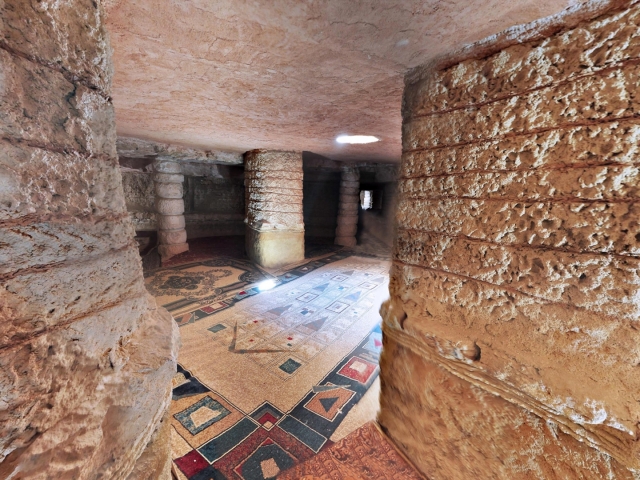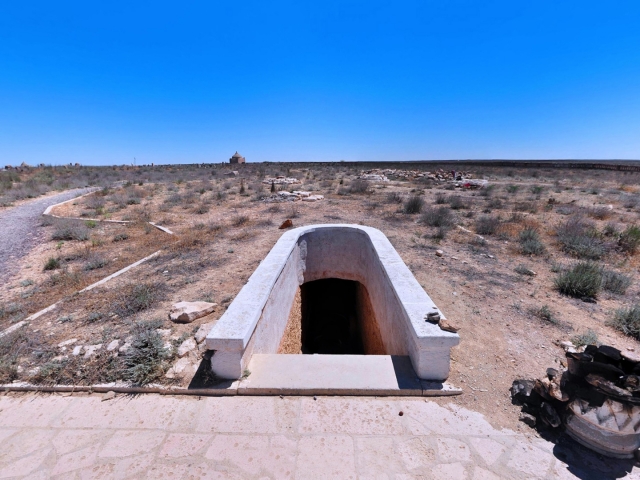Places
List of objects included in the map
Karaman Ata Necropolis and Underground Mosque (13th - 19th centuries)
Location: located in Mangistau district of Mangistau region 35 km to the south-west from Shetpe village.
Coordinates: N 43°53' 59.18", E 51°52' 19.25"
Description of the Monument: The monument was first investigated in 1951-1952 by expedition under the leadership of M. Mendikulov. M. Mendikulov refers the construction of Karaman Ata mosque to the 13th century. Karaman-Ata necropolis was researched by expeditions of the Ministry of Culture of Kazakhstan in 1977 under the leadership of A.O. Itenov and in 1979 under the direction of M. Nurkabayev. Upon Resolution no. 38 by the Council of Ministers of the Kazakh SSR dated 20.01.1982 the necropolis was taken under state protection with republican value category. By Order of the Minister of Culture and Sports of the Republic of Kazakhstan no. 119 dated March 30, 2015 the memorial was included in the governmental list of historical and cultural monuments of national importance. Resolution of Mangystau Akimat no. 414 dated 08.12.2010 approved the boundaries of the protected areas. In 2002, 2013-2014 RSE 'Kazrestavratsiya' prepared design and cost estimate documentation for the necropolis objects, and in 2014-2015 'Mangyshlakrestavratsiya' did research and restoration work. The necropolis consists of Turkmen stelae dating back to the middle ages, gravestones, many saganatams and mausoleums (2nd half of the 19th century – beginning of the 20th century), built by masters of the Adai clan (masters Omir Karauly and Nazar Omiruly). To the west from the necropolis there is underground mosque Karaman-Ata. The mosque is cut in a gentle slope of a small hill of marl rocks, perhaps the builders used the natural cave here. The underground mosque consists of 3 main premises. There are a corridor, a prayer room and a round room, where according to the legend the tomb of Karaman-Ata is found. The entrance area leads to the main gallery, where religious rituals, i.e. prayer take place. At the inner part of the roof, i.e. at the ceiling of the gallery two solid marl blocks and three columns are left to ensure the strength of the ceiling. Due to shallow depth of the building all rooms are low. On the external side of the roof there are two round light openings.
Historical Data, Legends and Stories: Karaman-Ata necropolis is one of the oldest and largest one in Mangystau. According to legends, at the grave of Karaman-Ata people used to give purification oath. Karaman-Ata went down in history of the Mangystau Kazakhs as a place of 'Oath Taking at Karaman-Ata'. An oath given in this place was considered sacred and inviolable.
There is preserved information of the middle of 19th century 'Legends of the Adais of the Saints who Lived and Died in Mangyshlak'. In these legends it is stated that Karaman Ata is the son of Yessen Ata and grandson of Shopan Ata. He was like his grandfather, worked a lot of miracles, built a mosque one day's journey from the grave of Shopan Ata. According to another legend, Karaman-Ata and Yessen-Ata were children of Shopan-Ata and there was an underground passage connecting the two mosques of these saints, but over the time this passage was filled up. In the folk's legend it is said that once there lived two brothers Akman and Karaman. They were honored by people as the saints. But one day they had a quarrel with Khoja Ahmed Yassaui. After this quarrel the brothers took their countrymen to the west, i.e. to Mangistau. This is one of the legends about Karaman-Ata and how the Oguz settled in Mangyshlak. Also among the residents of Mangistau there are many stories and legends about the strength and power of Karaman-Ata. In the place where Karaman-Ata first got on his feet, where he began to spread knowledge, there is now an eponymous necropolis, where people give purifying oath in the name of Karaman Ata. This land solved disputes between the peoples and clans, when intractable conflict could turn into bloodshed. Internecine fights ended here and everybody received satisfaction. Raised against each other battle axes (naiza) went down; naked bloodthirsty swords ready to rush into a battle were sheathed. The fire of slander and gossip went out, faces of the guilty got dark, and in front of innocent people a wide road of life opened. However no one was proud of his victory or boasted of his success. Heads bowed to the majesty of the great Kudret (Almighty). So not everyone decided to come to the tomb of the Saint (aulie) to ask him for justice. When a respected elder lowered her head in confusion, when no one listened to a bi endowed with unlimited power, and the words were wasted, only then people dared to come here. There is a story that once there was an argument between the Turkmens and the Adais. To avoid bloodshed and finish the dispute with peace they came to the grave of Karaman-Ata. At that time the Kazakhs used to bet the only son of a famous person. The choice fell on Koshan the only son of the famous batyr Kozha-Nazar. Becket Ata was involved to resolve the dispute. Becket Ata put 9-year-old Koshan on a black horse, stuck an awl in the saddle and said:
'Oh, Karaman Ata if we are wrong, punish us, if the black is wrong, punish the black'. The horse fell dead, and the awl flew away to several meters. When the baby began to fall together with the horse, Becket Ata managed to catch him.
'Beckett you sided your blood fellows, we do not agree with you', growled the Turkmens.
'Tomorrow then at the same time let's meet in the holy place of Shekepar (Sheikh-Kubira)' Becket Ata said and immediately turned into a white swan and flew up into the sky. Stunned by the miracle happened in their view the Turkmens admitted they were wrong and asked him pardon. So the legend goes.
Sources:
1. Legends of the Adais about the Lived and Died Holy Hanafiyah Sects in Mangyshlak. // Collection of Data about the Mountain Peoples of the Caucasus. 7 issues. Tiflis, 1873
2. 'Holy Places of Mangistau and Ustyurt' Serikbol Kondybai. 'Arys' Publishing House - 2007.
3. 'Underground Mosques in Mangistau' M. Kalmenov, O. Koshbaiuly - Almaty, Orkhon 2010.
4. Archives of Mangystau National Historical and Cultural Reserve, KPPM-232/17 (monument passport).
Views: 3967
Video
Маршрут
Hazret Yerzhan Burial
Shopan Ata Necropolis and Underground Mosque
Shakpak Ata Necropolis and Underground Mosque (14th–19th centuries)
Khatam-Ishan Mausoleum
The earliest structures here date back to the second half of the 17th c. The necropolis was developed in time and space in a circle, i.e. the most ancient constructions remained in the center. Out of the two extant domed mausoleums, the structure in the southern part of the necropolis is of particular interest. ...


















